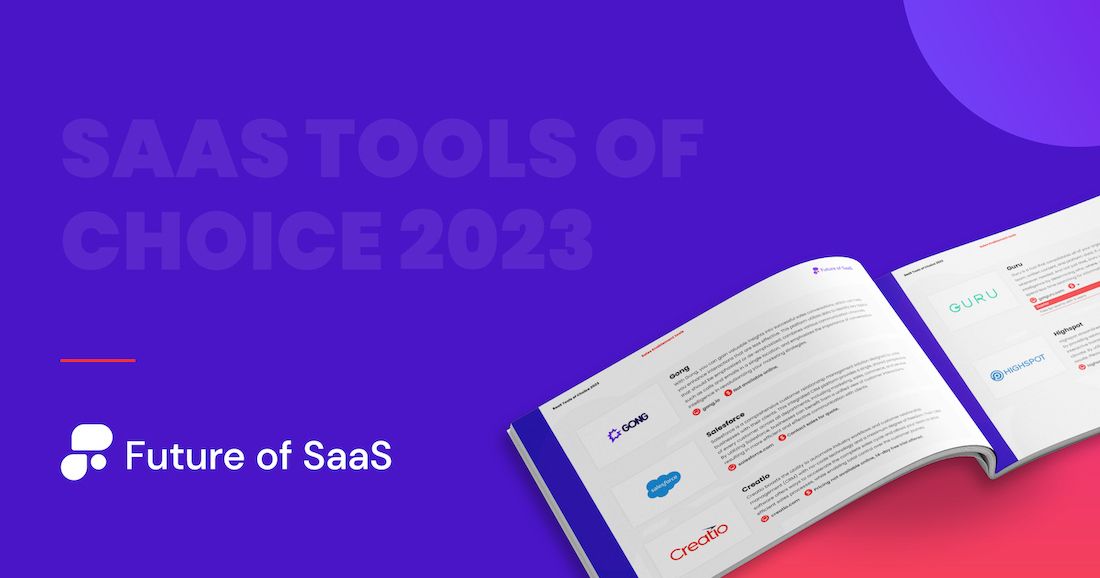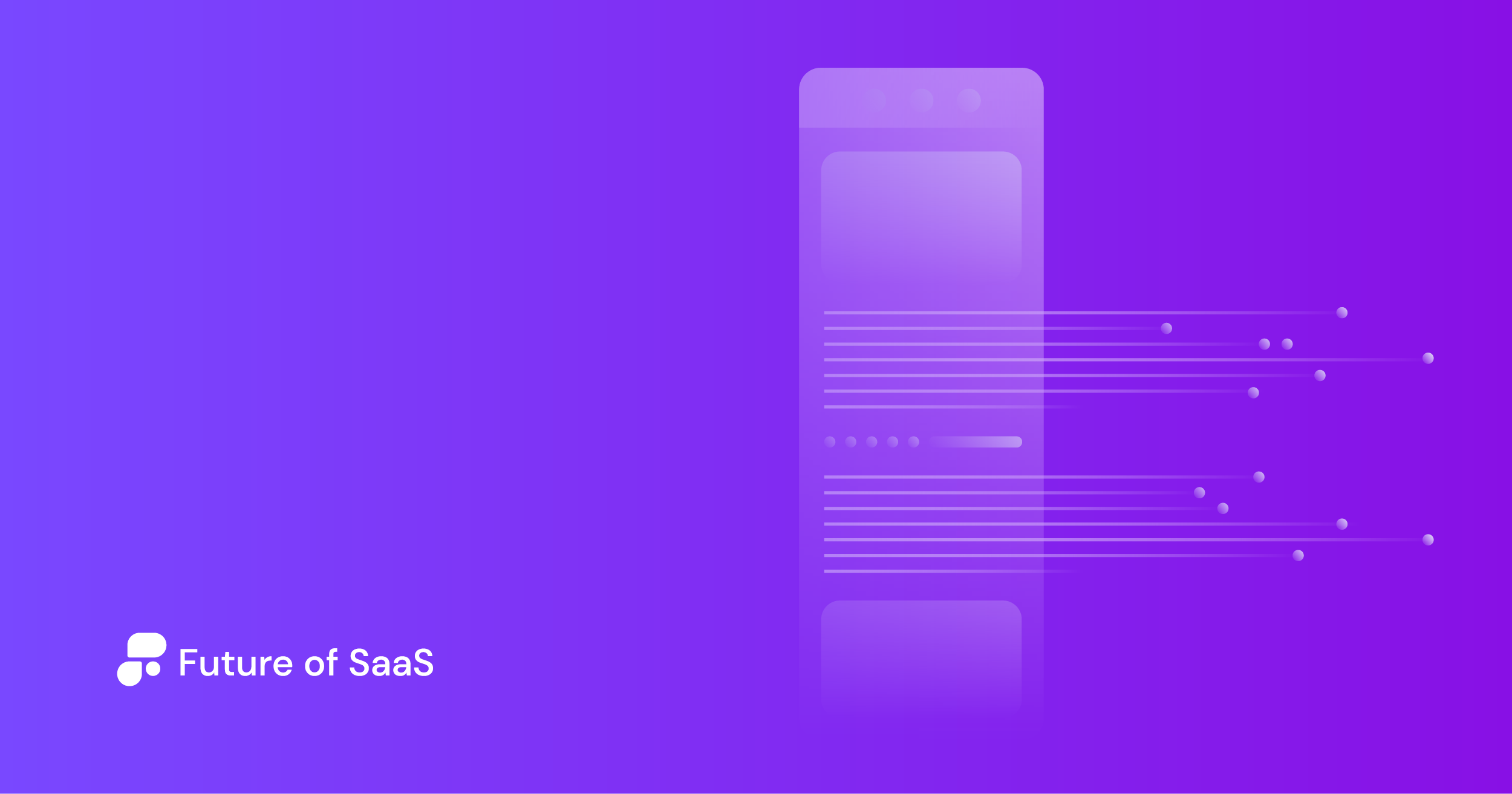The SaaS landscape is constantly shifting, and staying on top of the key trends is crucial for any business operating in this space.
From AI and security to vertical solutions and embedded finance, this article covers all the need-to-know SaaS topics.
With so much information available about the SaaS market in 2023, here's a curated snapshot of the current landscape.
The SaaS market is, without a doubt, growing at an explosive rate, going from $237.48 billion in 2022 to $273.55 in 2023 and projected to reach a whopping $908.21 billion by 2030. This means the SaaS industry has an 18.7% CAGR, which is pretty impressive in a post-covid space.
With 71% of companies relying on SaaS model applications, these continue to hold the first position as a real digital transformation driver.
It is estimated that by 2025, almost half of the world’s data will be stored in the cloud.
Two years from now, around 85% of all business products will be SaaS apps.
By 2025, 65.7% of spending on software applications will be directed to cloud services.
SaaS (software as a service) is a booming industry. There's no debate there, and with the rise of Artificial intelligence, SaaS applications are bound to become even more sophisticated and powerful.
As we are rapidly approaching 2024, embracing new technologies and staying up to date with the latest trends and advancements is no longer optional but essential for the growth of your business.
The only question that remains is where this ever-changing industry is going.
- What factors shape SaaS trends?
- 12 SaaS industry trends for 2024
- Final thoughts
What factors shape SaaS trends?
We can all agree that SaaS trends don’t appear out of thin air and are a real and legitimate thing. They are the direct result of factors that transform the way in which individuals and organizations perceive this industry sector.
- Customer preferences
- Market competitiveness
- Technology advancements
- Ever-changing regulatory and economic conditions
Customer preferences
As the software as a service market continues to grow, customer expectations are becoming well-established, and users are putting experience as a first priority.
In today’s landscape, among the preferences SaaS users value, the most popular are:
-- Dynamic pricing
-- Personalized services
-- On-demand solutions
-- Ease of use
-- Dedicated customer assistance
To fit the bill, emerging SaaS players need to use their knowledge and technology to enhance products. This would require them to first collect customer feedback, and then collaborate with market-recognized partners to benefit from their experience and transform the entire user experience.
Key takeaway:
Understand what value means to your customers and capitalize on it through strong partnerships and constant iteration of new and performing features.
Market competitiveness
With growth unicorns like Adobe, Salesforce, and Shopify, the total value of the SaaS market is booming.
While this is essentially good news, demonstrating that SaaS won’t be obsolete anytime soon, it can also be challenging for new businesses to make an appearance and gain a place at the leader’s table.
However, the growth of the market itself pushes potential SaaS developers to look for emerging industry segments like niche products. The thirst for revenue growth motivates them to roll out better products than what the competition has to offer.
Key takeaway:
Market competitiveness leads to continuous innovation and product improvement.
Technology advancements
With so much talk about trends like Artificial Intelligence, edge computing, or Vertical SaaS, global customers are more and more eager to put new technologies to the test.
To effectively respond to these expectations and offer customizable options, SaaS businesses need to adapt their product design and development to quickly integrate new technologies.
It is important to realize that the shift towards the DevSecOps practice, has almost 60% of businesses taking this step. This approach offers developers the option to continuously integrate new technologies, swiftly release different SaaS platforms, and maintain a competitive edge.
Key takeaway:
Keeping up with technology advancements has made SaaS developers reconsider their software development, facilitating future integrations.
Ever-changing regulatory and economic conditions
The path that led to the success the SaaS industry is now experiencing is due to nothing other than global trade.
However, even though SaaS products can easily reach global customers, they must also endure a large amount of compliance regulations and are subject to real economic turmoil.
Navigating the compliance landscape presents a significant challenge for SaaS providers, especially now with the emergence of AI rules and regulations.
Security and data handling audits have become legal requirements for SaaS businesses, complicating the global sale of software-as-a-service products more than ever.
Additionally, the economic environment is both an opportunity and challenge driver for SaaS businesses. Developers must prioritize pricing to stabilize customer acquisition and retention, regardless of economic changes.
Key takeaway:
SaaS providers need to prioritize customer security expectations and spending limits when defining the value of their solution.
12 SaaS industry trends for 2024
1. Cybersecurity
SaaS security has always been a serious concern for all those involved in the industry. Significant measures are taken to ensure that cyber threats are lowered in frequency and impact as much as possible.
Now, with the emergence of Artificial Intelligence, we’ve noticed a rise in the number of fraud attempts once again. The irony of this situation is that the use of AI has proven to be instrumental in increasing the level of security within the SaaS market.
Leveraging SaaS analytics with AI and ML technologies in complex solutions has shown that users can benefit from increased cybersecurity.
Moreover, a growing number of regulations are being implemented to lower cyber threats. SaaS companies need to abide by these standards, but it can be challenging to keep track of all changes that are now required.
Thus, we are witnessing more and more solutions to improve internal operational processing and lower product misconfigurations.
2. Focus on customer segments
If your goal is to be the ultimate SaaS champion, you might want to pin this SaaS trend, because it will never go out of fashion.
As the SaaS market matures, market demands are becoming more and more specific, which thankfully makes them easier to follow.
Software solutions need to create and release new product categories that are developed entirely around the user.
Think of Google or Netflix, which are fully customer-driven. SaaS vendors tend to go user-data crazy, and with good reason.
We recommend developing new revenue streams, based on a thorough understanding of your primary audience base while working on achieving an integrated system framework.
This will allow your in-house engineers and data experts to give you a more detailed image of your audience segments.
3. PaaS (Platform As A Service)
Estimated to reach over $300 billion in market value by 2030, PaaS is emerging as one of the strongest SaaS trends out there.
It provides enterprises with several noteworthy benefits:
Reduces costs on hardware maintenance.
Enhances efficiency and streamlines software development.
Ensure increased flexibility and mobility.
By choosing PaaS as an alternative, companies are able to focus more on enhancing their core product and avoiding the burden of having to tackle complex system maintenance.
4. Generative AI
When discussing SaaS innovations, generative AI, together with its spin-offs, and the large language models, have been the talk of the town.
ChatGPT is still fresh in the minds of users, and its success has opened the door to numerous AI uses. With an expected CAGR of 35.6% between 2023-2030, generative AI takes the first position among the latest SaaS trends.
This new technology helps SaaS businesses gain new and advanced software capabilities such as:
-- Content creation
-- Market research
-- Personalized support
-- Sentiment analysis
Generative AI has completely transformed the SaaS landscape, opening the doors for additional features for greater product enhancement or independent software development.
Whichever route you might be thinking of taking, this is one trend you don’t want to ignore.
5. SaaS market consolidation
With SaaS being a highly competitive market as it is, businesses are constantly looking for ways to gain the upper hand. Usually, in the land of technology, this means enhancing their products to better fit customer expectations and demands.
However, these ambitions come at a cost, and an increasing number of leading SaaS players have come to the conclusion that in-house feature development is time and resource-consuming.
Instead, more and more SaaS businesses are acquiring smaller companies in an effort to stay ahead of their rivals.
On the other hand, for startups, the prospect of joining forces with major players is a strategic approach to reducing competition and increasing their market share, influence, and profitability.
With no indication of the SaaS level of competition changing in any way and more and more examples of startup acquisitions, it’s reasonable to expect more consolidations in the near future.
6. Vertical SaaS
In the books for SaaS trends in 2023, Vertical SaaS will continue to maintain a high level of popularity in 2024. Estimated to reach $157 billion by 2025, there is still room for more players in this young market.
Unlike horizontal SaaS, the very essence of vertical SaaS tools is that of resolving specific industry challenges, following the future agenda of the entire SaaS industry.
Think of these user-friendly, pre-built, tailored solutions as market experts with a deep understanding of a specific topic.
Given the customer-centric era we are living in, vertical SaaS is bound to maintain its leading position and high popularity, especially in industries like insurance, healthcare, or finance.
7. Micro SaaS products
Very much like Vertical SaaS solutions, micro SaaS companies come to service a specific industry, audience segment, or even use case.
Dominated by recognized players like Salesforce with a market value of $183.07 billion or Adobe, $152.37 billion, SaaS startups face formidable odds when competing head-on with established solutions such as these.
That is why most smaller businesses choose a more strategic gameplan, based on an advanced customer segmentation. By offering a solitary product, finely tailored to a specific market segment with distinct needs, SaaS businesses are actually competing in smaller markets, with a lower competition level.
Not only that but micro SaaS solutions can be developed and launched fast, with minimal resources. This gives developers a great advantage to quickly respond to customer demand, technological advancement, or market changes.

8. RevOps
In the midst of the profound transformations in market dynamics, SaaS businesses struggle to grow while maintaining profitability.
Unless they strategically manage their sales and marketing operations, the huge upfront investments, competition, and challenging customer retention can take a toll on their success.
RevOps, short for revenue-operations tools, are perceived as the next thing in forecasting and predictive analytics for the sales and marketing sectors.
Rolled into one end-to-end SaaS app, RevOps tools offer the bird’s eye view that all business developers seek.
Aligned with machine learning and AI capabilities, these cutting-edge solutions allow users to:
Focus on operational automation.
Enjoy complete visibility across the entire sales funnel, including the marketing and customer service phases.
Gather sufficient insights to enhance conversion rate boosts.
Move from isolated frameworks to an integrated solution hub.
Effectively implement a data-driven customer success program to identify additional revenue opportunities.
When it comes to successful RevOps solutions that are greatly popular, we can definitely mention the advanced lead-scoring system, based on customer behavior.
Based on ML algorithms, lead-scoring platforms can provide sales experts with a targeted list that is more likely to convert.
This SaaS trend looks at cloud platforms that can streamline and increase team productivity through strong analytics capabilities.
9. Flexible API-based infrastructure
Remember how we said that one of the factors that set the SaaS trends is technological advancement? We weren’t exaggerating. One of the ingrained features (and benefits) of a SaaS solution is faster and easier product scaling.
But you can only take advantage of this if you carefully plan for future scalability within the early stage of the product development.

Today’s SaaS world is shifting from a solution-first view, extensively used in SaaS product creation, to a problem-solving approach that involves a flexible architecture with a scaling trajectory based on user feedback.
What does this mean? Creating a five-year product roadmap is no longer a viable option. A micro-service-based and API-connected infrastructure, on the other hand, is. And it’s currently one of the most popular market trends.
Why? Because it gives cloud based software solutions greater scalability and a faster time to market.
10. BI powered SaaS tools
By 2030, the SaaS BI solution market is expected to reach $35.71 billion, clearly indicating that this is an untapped and huge opportunity for developers.
Only by looking at market leaders and analyzing their customer retention and acquisition efforts, you would notice a pattern: organizations are relying on data to identify strong audience pain points and develop features around them.
Unlike on-premise solutions, SaaS apps have the unique advantage of extracting data straight from the source. This is actually why this market trend fits the software as a service industry like a charm.

Combined with artificial intelligence technologies and machine learning algorithms, BI-powered SaaS tools can provide users with comprehensive information that can lead to better operational automation.
Furthermore, while building stand-alone BI solutions is a great way to take advantage of this market opportunity, it’s not the only road to take.
You can deliver greater value and increase business profitability by adding BI capabilities to existing SaaS systems.
11. Embedded finance
One of the latest payment trends for 2024 is embedded payments. The integration of embedded payments streamlines the overall payment experience for customers, making transactions more convenient and efficient.
The increasing popularity of digital payments, together with the impressive rise of the gig economy and the increasing demand for alternative payment methods in emerging markets, explain the apparition of this trend.
Through strong partnerships with key players, SaaS companies can offer customers a wider range of payment options without having to build and maintain their own financial infrastructure.

12. No code/low code platforms
Even though code still rules, no code and low code platforms are gaining more and more popularity. Low code and no code platforms offer business owners two major advantages - flexibility and efficiency.
These solutions allow business owners to focus less on complicated and time-consuming programming tasks and more on customer experience and growth strategies.
Ideal for developing both desktop and mobile applications and using Open API for faster software development, these solutions make it simple for businesses to automate complex operations and significantly boost profitability.
Thanks to the no-code/low-code trend, the SaaS market is no longer a programmer’s world!

Final thoughts
There is no question that the SaaS industry is enjoying unprecedented growth and, above all else, transformation.
Embracing new technologies, considering vertical SaaS trends, keeping systems open for fast scaling, and remaining flexible in product development are just some of the directions well worth pursuing in 2024.
Part of becoming a SaaS champion is keeping your options open and closely watching how the industry shifts. Another equally important part is successfully facing up to the many challenges this market holds in store for SaaS vendors.
From constantly evaluating and responding to customer needs to choosing the right partners that can help streamline operations, businesses have a lot on their plate.
Like what you see? Why not check out exclusive strategies from the leading minds with a Future of SaaS membership? 👇





